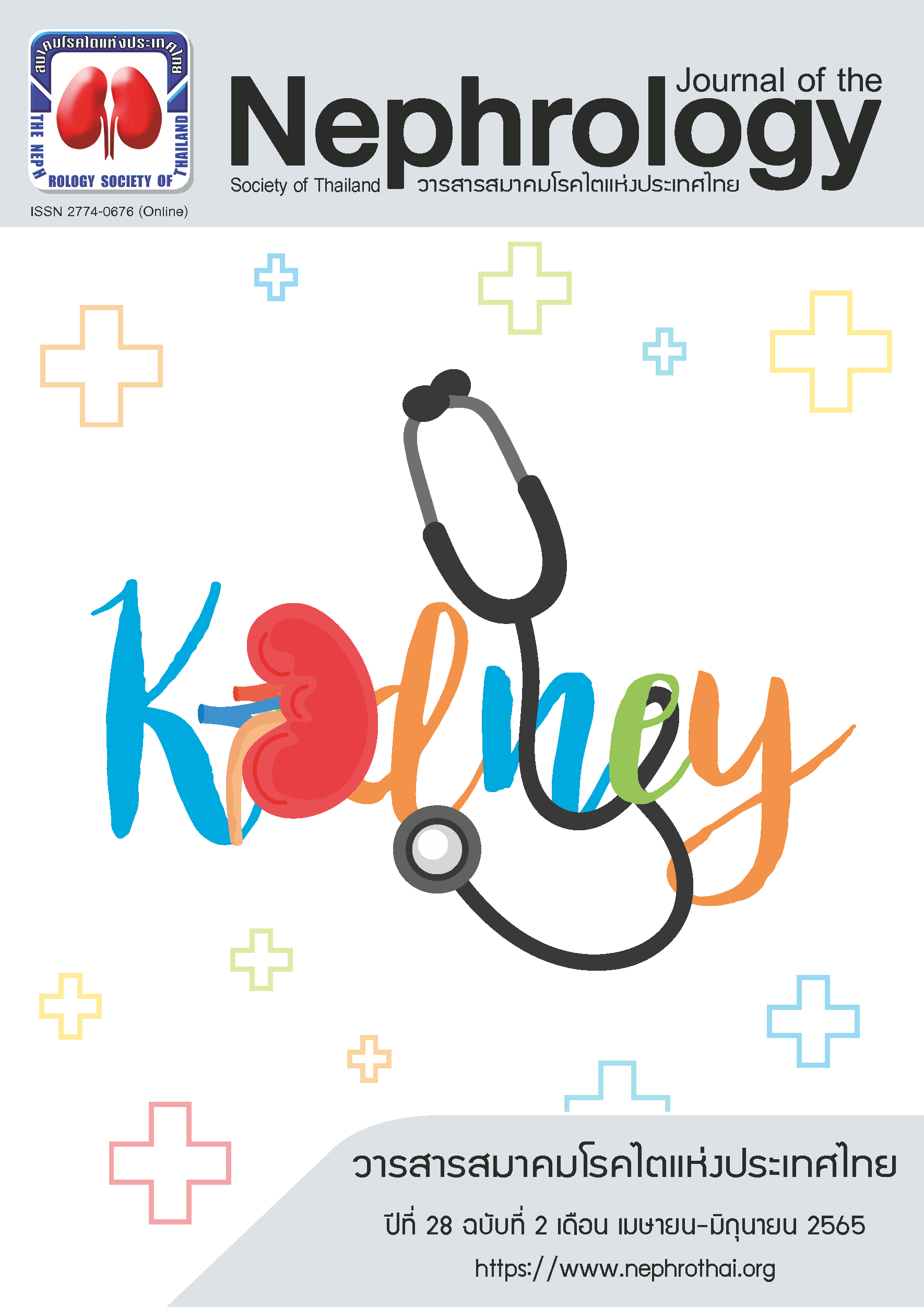Tacrolimus dose prediction during the perioperative period among Thai kidney transplant recipients
Main Article Content
Abstract
Background: Tacrolimus (TAC) is the cornerstone of immunosuppressive drug therapy after kidney transplant (KT). Achieving target TAC concentrations as soon as possible is crucial, especially during the early posttransplant period. Too low or too high tacrolimus exposure can lead to unfavorable complications. This study aimed to develop an equation to predict achieving target tacrolimus dose used at days 3-5 of post KT surgery.
Methods: A retrospective cohort study was conducted at King Chulalongkorn Memorial Hospital, Thailand. We divided subjects in 2 cohorts; the first developmental cohort was KT recipients from 2015-2018 and the second was a validation cohort from 2019-2020. The dose prediction model was developed based on exponential function due to nonlinear association between target TAC dose (mg/kg) and 12-hour level after the first dose (TAC C12).
Results: A total of 206 KT recipients was enrolled, 140 KT recipients in the developmental cohort and 99 (70.7%) deceased donor KT recipients. Mean TAC dose used days 3-5 post-transplant was 5.8 ± 1.9 mg/day in the developmental cohort the same as the TAC dose used in the validation cohort 5.8 ± 2.1 mg/day. We calculated the dose of TAC for achieving an average therapeutic level of 8.5 ng/mL days 3-5 post-transplant involving the equations below.
Adjusted TAC dose days 3-5 (mg/kg) = 0.2588691* TAC C12(-0.47730647) * Hemoglobin (-0.03101605)
The R2 of the developmental cohort was 0.3125 and that of the validation cohort was 0.2929. Mean absolute error (MAE) of TAC dose was 0.0392191 mg/kg.
Conclusion: The TAC dose prediction equation developed from clinical factors, could guide nephrologists to adjust TAC dose during perioperative KT among individual patients and this optimization could reduce both TAC toxicity and KT rejection rates.
Article Details

This work is licensed under a Creative Commons Attribution-NonCommercial-NoDerivatives 4.0 International License.
This article is published under CC BY-NC-ND 4.0 license, which allows for non-commercial reuse of the published paper as long as the published paper is fully attributed. Anyone can share (copy and redistribute) the material in any medium or format without having to ask permission from the author or the Nephrology Society of Thailand.
References
Mehrabi A, Wiesel M, Zeier M, Kashfi A, Schemmer P, Kraus T, et al. Results of renal transplantation using kidneys harvested from living donors at the University of Heidelberg. Nephrol Dial Transplant 2004;19 Suppl 4:iv48-54.
Issa N, Kukla A, Ibrahim HN. Calcineurin inhibitor nephrotoxicity: a review and perspective of the evidence. Am J Nephrol 2013;37(6):602-12.
Borobia AM, Romero I, Jimenez C, Gil F, Ramirez E, De Gracia R, et al. Trough tacrolimus concentrations in the first week after kidney transplantation are related to acute rejection. Ther Drug Monit 2009;31(4):436-42.
Kramer BK, Del Castillo D, Margreiter R, Sperschneider H, Olbricht CJ, Ortuno J, et al. Efficacy and safety of tacrolimus compared with ciclosporin A in renal transplantation: three-year observational results. Nephrol Dial Transplant 2008;23(7):2386-92.
Webster AC, Woodroffe RC, Taylor RS, Chapman JR, Craig JC. Tacrolimus versus ciclosporin as primary immunosuppression for kidney transplant recipients: meta-analysis and meta-regression of randomized trial data. BMJ 2005;331(7520):810.
Yu M, Liu M, Zhang W, Ming Y. Pharmacokinetics, Pharmacodynamics and Pharmacogenetics of Tacrolimus in Kidney Transplantation. Curr Drug Metab 2018;19(6):513-22.
Shuker N, Shuker L, van Rosmalen J, Roodnat JI, Borra LC, Weimar W, et al. A high intrapatient variability in tacrolimus exposure is associated with poor long-term outcome of kidney transplantation. Transpl Int 2016;29(11):1158-67.
Kim IW, Moon YJ, Ji E, Kim KI, Han N, Kim SJ, et al. Clinical and genetic factors affecting tacrolimus trough levels and drug-related outcomes in Korean kidney transplant recipients. Eur J Clin Pharmacol 2012;68(5):657-69.
Kim IW, Noh H, Ji E, Han N, Hong SH, Ha J, et al. Identification of factors affecting tacrolimus level and 5-year clinical outcome in kidney transplant patients. Basic Clin Pharmacol Toxicol 2012;111(4): 217-23.
Chen L, Prasad GVR. CYP3A5 polymorphisms in renal transplant recipients: influence on tacrolimus treatment. Pharmgenomics Pers Med 2018;11:23-33.
Townamchai N, Chancharoenthana W, Vadcharavivad S, Chariyavilaskul P, Pongpirul K, Leelahavanichkul A, et al. A Simple Novel Technique to Estimate Tacrolimus Dosages During the Early Post Kidney Transplantation Period. Transplant Proc 2015;47(8):2433-8.
de Jonge H, de Loor H, Verbeke K, Vanrenterghem Y, Kuypers DR. In vivo CYP3A4 activity, CYP3A5 genotype, and hematocrit predict tacrolimus dose requirements and clearance in renal transplant patients. Clin Pharmacol Ther 2012;92(3):366-75.
Jacobson PA, Oetting WS, Brearley AM, Leduc R, Guan W, Schladt D, et al. Novel polymorphisms associated with tacrolimus trough concentrations: results from a multicenter kidney transplant consortium. Transplantation 2011;91(3):300-8.
Hesselink DA, van Schaik RH, van der Heiden IP, van der Werf M, Gregoor PJ, Lindemans J, et al. Genetic polymorphisms of the CYP3A4, CYP3A5, and MDR-1 genes and pharmacokinetics of the calcineurin inhibitors cyclosporine and tacrolimus. Clin Pharmacol Ther 2003;74(3):245-54.
Tsuchiya N, Satoh S, Tada H, Li Z, Ohyama C, Sato K, et al. Influence of CYP3A5 and MDR1 (ABCB1) polymorphisms on the pharmacokinetics of tacrolimus in renal transplant recipients. Transplantation 2004;78(8):1182-7.


